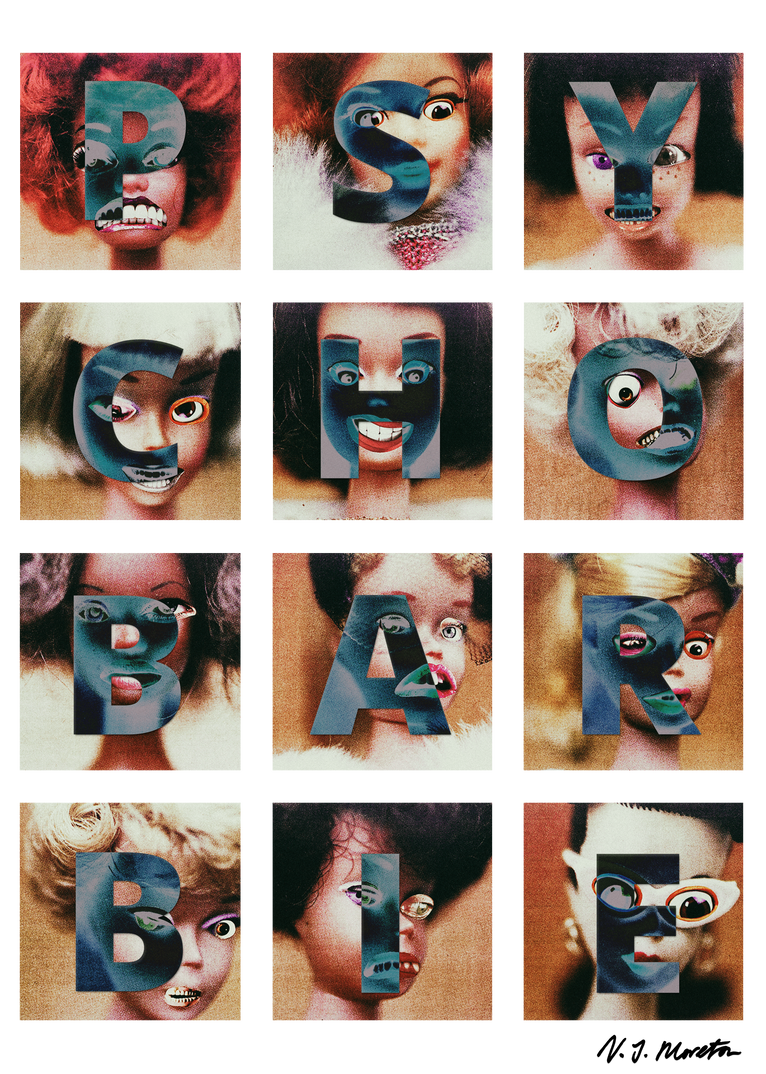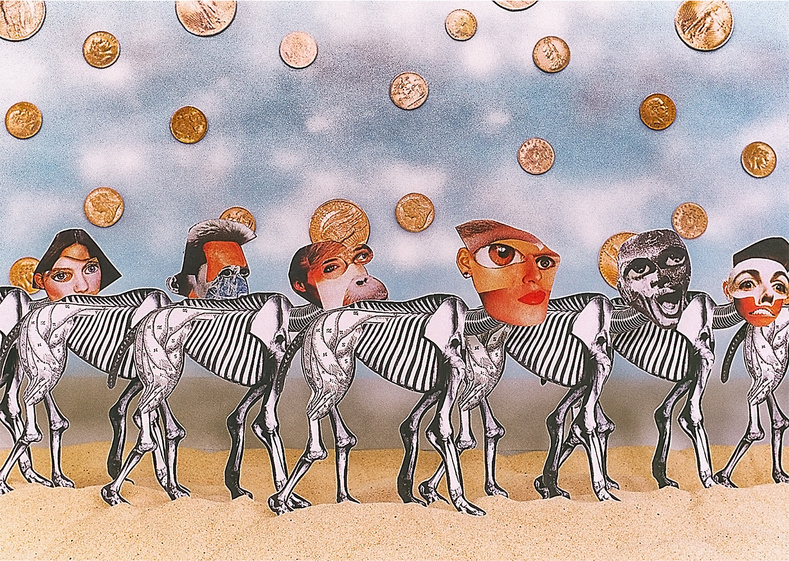



"An archetypal quest and its attendant vulnerabilities are re-fashioned within a contemporary mould: imbued with a robotic archaeology, innards exposed, VJ Moreton’s characters and symbols draw attention to a disturbed evolution."

V J Moreton at his Space exhibition [2009]

VJ Moreton's studio at Spike Island Studios, Bristol, UK [2009]
"I don’t have to carry a computer around with me, just a pair of scissors and a bit
of glue, paper and images."

Abstract
It was at the house of an old friend, Barbara Carlile, who owned and ran a gallery by the same name in London in the early 1980s, that I first encountered the art of VJ Moreton.
...works present graphic images of composite human bodies and faces, their characteristic attributes distorted, split, mutated, at times inverted or rotated.
VJ Moreton transforms such concepts into a theatrical language for staging an acute and colourful vision.The mise-en-scene relies on precise visual techniques.
Constructed realities together the animate and the inanimate in an inescapable stranglehold; the interaction between actors and material symbols appears enigmatic.
Conceptually, the clean and crisp vocabulary of image making is rooted in a distillation of the many artistic sources and developments that inform the work and reinforces its stark impact. Meticulous planning and crafting through creative procedures precede the final image:collages are assembled and the mise-en-scene of protagonists painstakingly devised.
Three-dimensional sets are constructed complete with skies, white clouds, smoking chimneys and skies covered in coins.
A pebbled earth, a sandy beach, a snow scene, nature and architecture reduced to barren and desolate environments serve as the cliché milieu in which the animate and inanimate interact. The final scenes are photographed under precise lighting conditions.
VJ Moreton’s devotion to the craft of art awards the works a unique presence, technically meticulous, and located somewhere between the many disciplines involved in the creative process. Animations are constructed from fragmented components mined from historical and contemporary imagery. Avoiding the use of Photoshop, in the artist’s own words “refusing to bland out the picture”, results in works which speak with clarity.
VJ Moreton’s animated theatre of the absurd harbours tragi-comic undertones confirming the inevitability of this paradoxical state.
Christine Kapteijn

V J Moreton & Christine Kapteijn [2009]
Conversation: VJ Moreton and Christine Kapteijn
CK: You acknowledge that you stand on the shoulders of many world famous artists, so how would you express that relationship?
VJ: This is a homage to both George Grosz and John Heartfield (Homage to the Monteurs), two artists I admire very much. Heartfield always called himself an engineer, a photo engineer. The film director André de Toth said something like: there’s no point in copying others and do it badly. It is better to do something original, at least it is yours. That’s what I aim for.
VJ: I had an exhibition of ceramics once and learned that doing art by committee is not the way to make art. I had the vision, and they didn’t.When I told them what I wanted they said it would be better if I did it differently. And then afterwards I realised that I should have just done what I wanted to do. It really dispirited me for a long time, knocked me back. I realised from then on that if you are doing a public art commission, you just have got to steam ahead.You need that wow factor with any art, especially public art. But that happens you know, we learn. [Continued...]
Conversation continued...
CK: You have to acknowledge failure in order to develop. Failure is a more effective teacher.
VJ: The best way, really, to make my work is to computer it. But I like the fact that it is cut and paste. That’s my thing.
CK: I know, I know. That’s why it’s so special.I find your work interesting, partly, because you do not use a computer. It is incredibly off mainstream as a result but also has a very direct impact. I think young people will really respond to it.
VJ: Everyone does that computer stuff and it gets blanded out, anyone could do it. The way I do it not anyone can do it, but the materials are there to hand. I don’t have to carry a computer around with me, just a pair of scissors and a bit
of glue, paper and images.The technical side takes years to work out. I make it look easy, but it’s not. You have to learn how to do it.

Conversation continued...
VJ: This is another Eve and Adam, I did a couple. Well, in one Eve’s giving Adam a hand grenade and in the other she is giving him a brain (Eve and Adam No 1 and No 2).
CK: She would, wouldn’t she? That’s very (laughs) contemporary actually. He looks a pretty dopey guy, doesn’t he.
VJ: What, there, oh yeah, pretty stupid most of them are ------
might well be one myself. Even though I don’t need it, I turn it round the other way. Well, it’s been building up for many years now. But you’ve given me the opportunity to do something I’ve wanted to do for a long time. You get your enthusiasm then, not compromising so much.
CK: There is a barren look about the images. The horse appears quite often like a visual metaphor.
VJ: Means a lot in different cultures. Yeah, it’s like a plain based on George Stubbs(Newmarket Heath, with a Rubbing- Down House c1765). He’s got just flat land, tiny trees in the background. Then there are his horses there, and that’s all it is. I like these big strong images. [Continued...]

Eve and Adam No.1

Eve and Adam No.2
Conversation continued....
CK: They’re very strong as a herd, these horse figures. (No. 13 Act 2. Scene1.) You really got the scale right, didn’t you? Oh, you’ve got a pile of coins there in that sky.
VJ: It’s a herding instinct, well, just chasing the money. That one might need redoing.
CK: Why do you have to redo it?
VJ: I’ll show you why. Sky’s not very interesting in this one, bland. On some days I get sunned off, instead of rained off, so I just wander off until it gets cloudy or rainy.
CK: What lighting suits you really?
VJ: When you don’t get the depth of field, you don’t get the clarity all the way through, especially when you’re bringing the images up, the foreground, middle ground, distance. I want to give a real sense of distance to it: but all in focus.
CK: How do you cut out the figures?
VJ: With a knife. Hardest bit is thinking it up, then cutting it all out, some of them on thicker card.This thicker card - it’s a pain, takes a lot longer. Once I get going I whizz through. Getting all the pieces, the components, takes the time.

No.13 Act 2. Scene 1 [2009]

No.15 Act 2. Scene 3 [2009]
Conversation continued....
CK: Well, it’s like anything, getting the components lined up takes the time. People often don’t realise that. This particular work is about split personalities, isn’t it? (Triptych No. 1 Cloning, Splitting, Mutating)
VJ: Yeah, yeah, one side is reversed, that’s what it is about. I cut the image up right down the middle, that’s what that line is. That distortion is what they are about: cloning, mutating, splitting. I’ve done them for a long time, this kind of stuff, but these have been refined from the black and white works. Looks very simple, but it is quite complex, the best way, simple but complex.
End.

Triptych No.1 Cloning, Splitting, Mutating [2009]
Mock of Ages


Address
Under Construction
thisisvjmoreton@gmail.com
